The Soviet Art of Photography
Workers
Belorussia, Minsk

|
Women working a seven hour shift on the assembly line, build tractors in a highly automated factory. Over 60,000 tractors are produced by this small plant every year. (circa 1950s)
|
Estonia, Tallinn
| Building radios on an assembly line. Workers on a seven hour shift are surrounded by ample sunlight and plants hanging from the ceiling.(circa 1950s)
|

|
Georgia

|
A Jewish worker in a small butcher shop slaughters an animal observing kosher.(circa 1980s)
|
Russia, Bashkortostan
| A technician keeps careful watch over 200 electric oil wells, while potted flowers sit above both workers. Men and Women oftentimes worked side by side in the Soviet Union, where 75% of women were working full time jobs by the 1950s. (circa 1950s)
|

|
Russia
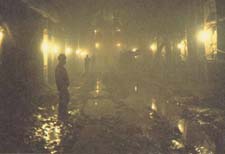
|
Construction workers complete the 1.2 kilometre long Nagorny Tunnel, having spent 18 months drilling through solid rock and ice. (circa 1980s)
|
Russia, Moscow
| Civil Service workers sweep leaves gathered on the grassy penisula of the Lenin Prospekt. (circa 1980s)
|
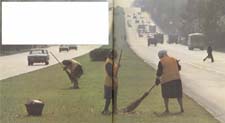
|
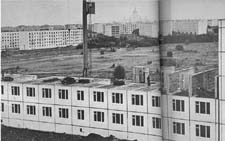
|
An example of the rapidly built, pre-fabricated, apartment complexes built throughout the Soviet Union to ensure all people had adequeate housing. (circa 1950s)
|
|
A pre-fabricated living room is hoisted into place.(circa 1950s)
| 
|

|
Masons attach pre-made walls to the next story, and highlight good and bad examples of proper working posture (the woman on the right is squating, allievating stress on her back, while the woman on the right is constantly bending over). (circa 1950s)
|
| Women construction workers take a break. (circa 1980s)
|

|
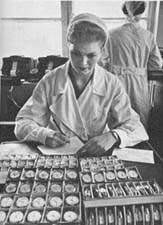
|
Larissa Kuzina examines watches before they are shipped out in Watch Factory #2. (circa 1950s)
|
| Boris Veprintsev, a biophysicist, records the sounds of nature for urban children to hear.
|

|
Russia, Moscow (Leninsky Komsomol Automotive Plant)
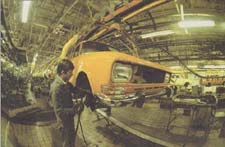
|
An assembly line worker workers on the axel of the car. Every workplace in the Soviet Union provided more than just work — they also provided a variety of social services related to work and pro-actively built a sense of community among workers. (circa 1980s)
|
| On their break, three employees talk about a painting. Behind them is a board of notices announcing shows and classes employees can attend. (circa 1980s)
|

|

|
Injured workers recieve physiotherapy to help them overcome workplace accidents. (circa 1980s)
|
|
While their parents work, children play in a lavish day-care center. Soviet children, like all children in the world, received the best of what society had to offer. (circa 1980s)
| 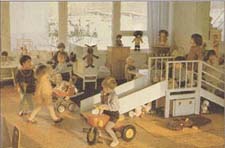
|
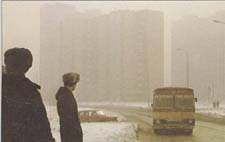
|
Workers wait for the morning bus. (circa 1980s)
|
| Near the factory, older workers swim during the day in a 50 meter pool housed in a massive sporting complex that also holds a skating ring, a gym, and a stadium. (circa 1980s)
|
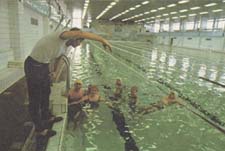
|

|
In the Palace of Culture, an area nearly all work places have (even if only in the form of a small library and reading room), workers stage an amateur theatre production after work. (circa 1980s)
|
Russia, Siberia
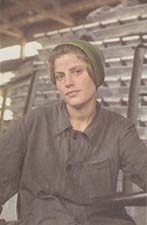
|
A forklift operator. (circa 1980s)
|
| Mechanics thaw and wash parts of a drill with petrol. (circa 1980s)
|

|
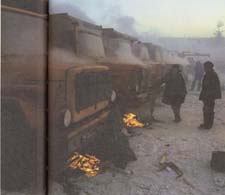
|
In Siberia, these truck engines have fires lit underneath them all night and day to prevent engine parts from busting open. The tempature here is around - 45 degress C. (circa 1980s)
|
Russia, Siberia
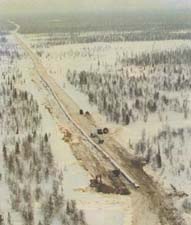
|
A natural gas pipeline is laid in the Taiga. (circa 1980s)
|
Russia, Volga River
| A worker and his family float timber down the river. (circa 1950s)
|
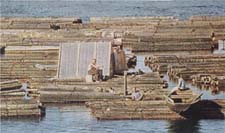
|
Russia, Siberia, Yatutsk (Building the BAM)
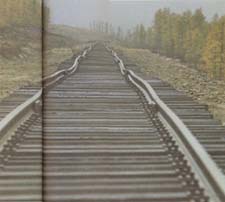
|
Newly laid tracks rest in the artic cold. In some places they cannot be used for two years — the wrenching permafrost will move and settle the tracks resting on 2 meters of freshly laid rock. The BAM — Baikal-Amur Mainline — stretched 3,200 kilometers from Siberia's Lake Baikal (where it joined the trans-siberian railway) to the Amur River on the Pacific, costing the equivelent of seven billion pounds. The railway crossed seven mountain ranges, spanned 3,700 gorges, swamps, streams and rivers. Two-thirds of the railway was laid over permafrost, while the region is one of the most earth quake prone in the world. Thus, workers laid 500 meters of track a day. (circa 1980s) |
| Men working beside women, lever a section of the track into place. (circa 1980s)
|
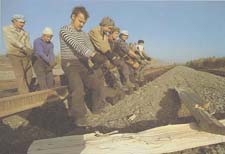
|
|
Siberian Yakuts and Russians lay a prefabricated section of track.
| 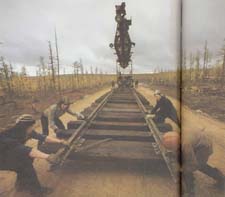
|

|
Musicians flown in from Estonia provide entertainment for workers at break time. Similar to other nations who fly celebrities abroad to entertain their soliders at war, in the Soviet Union celebrities were flown to massive working projects such as the BAM. (circa 1980s)
|
Miscellaneous
|
Cotton pickers in Central Asia loading the harvest.(circa 1950s)
|

|
Ukraine, Kiev
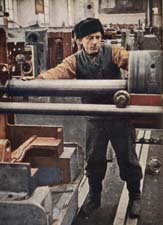
|
A worker at the Gorki Automatic Tool Plant. (circa 1950s)
|
Uzbekistan, Samarkand

|
A worker operates a silk spinning machine. (circa 1950s)
|
Transcription/Markup: Brian Baggins
Online Version: Soviet History Archive (marxists.org) 2001






























